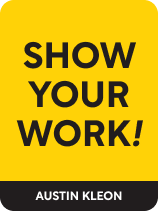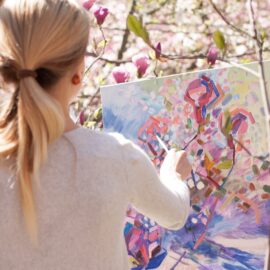

This article is an excerpt from the Shortform book guide to "Show Your Work" by Austin Kleon. Shortform has the world's best summaries and analyses of books you should be reading.
Like this article? Sign up for a free trial here .
Why should artists track their progress? What is the best way to track your work’s progress?
In Show Your Work!, Austin Kleon says that documenting and tracking your progress can help you study your methods and enhance your skills. To document the creative process, you can use a smartphone or any other recording device for filming.
Keep reading below to learn how to track progress and why it’s essential for artists.
The Importance of Tracking Progress
Before you can start sharing your work, you must gather material, claims Kleon. A way to do this is to simply document your work. Use your smartphone or some other device to record what you’re doing at any stage in the process. Not only will such photos and videos serve as material to post online, but they’ll also help you study your methods and develop your skills and techniques. Below, we’ll look at ways to learn how to track progress.
Document Every Phase in Your Process
Kleon believes there’s worthwhile material to capture at any phase of your process.
If you’re in the early stages of making your piece or don’t yet have any work to show, consider sharing the work of artists who’ve inspired you. For instance, if a poem gave you the idea for the piece you’re starting, share it, advises Kleon. You’ll find that other people like that same poem. They’ll then realize you have something in common, and they’ll likely take an interest in your work when it’s ready to share.
Just note that if you share the work of others, you must be comprehensive in giving attribution. According to Kleon, the most important attribution online is the hyperlink—be sure to include it so it’s easy for people to find the source. If you don’t know where a work came from, Kleon says, don’t share it. Proper attribution is a great way to build real connections with like-minded people, and it’s also just the right thing to do.
If you’re in the middle of your process, show people what you’re doing and how you’re doing it. Share your research for your novel, geek out about your red sable paint brush, ask others how they record acoustic guitar in stereo, and so on. Teach what you’ve learned. These kinds of posts are engaging and sure to attract those who care about the same things.
If you’ve just finished a piece—show it, insists Kleon. Then show the outtakes and edits. This kind of transparency makes you more accessible to people and helps them get to know you.
Kleon writes that if you have many finished works, tell people about opportunities you may have coming up: a gallery showing or a book reading, for instance. Share your memories of how a certain work came to be, or ask for constructive feedback. Kleon claims there’s always a way to help people engage with your work at any phase.
(Shortform note: While it’s important to show your finished piece or pieces, it’s also important to steer clear of bragging about opportunities or successes you’ve had. Studies show that bragging—whether explicitly or implicitly (the “humble-brag”)—makes you less likable. A better approach is to stay humble. Share your gratitude, share the facts, share when you’re asked, or hire someone to promote you, so you don’t have to talk about yourself.)
The Best Way to Improve: Deliberate Practice
By tracking your creative progress, you can study your techniques, learn from your mistakes, and take deliberate steps toward improving. This is an element of a particular approach to improving your skills called “deliberate practice.” In his book Peak: Secrets From the New Science of Expertise, psychologist Anders Ericsson coined that term to describe the best way to efficiently improve your skills in any area.
Deliberate practice involves several components:
- Evaluate your performance with precision: For instance, record the exact speed at which you play a challenging piece of music.
- Engage in competition: Aspire to be the best.
- Follow best practices: Don’t concern yourself with pioneering a new technique. Instead, follow time-tested strategies.
- Be coached: Seek out the guidance of experts—take their advice and learn from their insights.
- Work hard: If you want to improve a lot, you have to put in a lot of effort.

———End of Preview———
Like what you just read? Read the rest of the world's best book summary and analysis of Austin Kleon's "Show Your Work" at Shortform .
Here's what you'll find in our full Show Your Work summary :
- How to succeed at your creative endeavors
- How to make money off your creative work
- Why you should share your creative process






